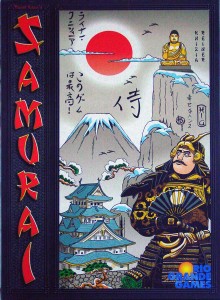Review: Samurai
Posted by James (admin) on September 8th, 2010
 In Reiner Knizia’s classic game, players take turns placing hexagonal tiles from their hand onto a map of Japan where some of the hexes (villages, towns and cities) contain one or more of the 3 types of markers (helmets, rice fields, buddhas). When a location containing one or more markers is surrounded by tiles (sea areas don’t need to contain tiles), the tile strengths of each player are added up and the player with the greatest relevant strength wins the relevant marker. Many tiles’ strength only counts towards capturing one of the 3 types of markers but a few (like the Samurai) count towards all types.
In Reiner Knizia’s classic game, players take turns placing hexagonal tiles from their hand onto a map of Japan where some of the hexes (villages, towns and cities) contain one or more of the 3 types of markers (helmets, rice fields, buddhas). When a location containing one or more markers is surrounded by tiles (sea areas don’t need to contain tiles), the tile strengths of each player are added up and the player with the greatest relevant strength wins the relevant marker. Many tiles’ strength only counts towards capturing one of the 3 types of markers but a few (like the Samurai) count towards all types.
For example, a hex on the coast containing a Buddha maker has the following tiles around it: Red 2 buddha, Red 2 samurai, Yellow 4 helmet, Yellow 1 Samurai, Green 3 buddha. As the other hex around this location is a sea hex, the village is surrounded. In this case, Red wins the Buddha because they have a total of 4 towards capturing buddhas. Green’s total of 3 isn’t enough, and neither is Yellow’s total of 1 because their helmet tiles doesn’t count towards capturing buddhas.
Some tiles can be played in addition to your usual one tile, one tile lets you re-play a tile already played and another tile lets you swap two markers.
When all of one type of marker in the game has been claimed (or players have tied on a total of four markers), the game ends and the winner is the player who has the majority of 2 types of markers. Usually players will tie by each having majority of just one type and, in this case, the players add up the number of markers they have but not including the type in which they have the majority – the player with most markers not part of their majority wins.
 Overall, Samurai is a great game – extremely simple to learn and fast to play but it still has some very tough and satisfying decisions to make. Placing tiles strategically is the most important element – especially if you can place tiles to be effective in battles for more than one marker; plus, timing when to play some of the special tiles is key. However, you constantly need to think about which markers you’re fighting for – you need lots of at least one type of marker to get at least one majority but you also need to collect the other types of markers too so you can win a tie situation. With 3 or 4 players, markers are kept hidden behind a screen which means you need to try and remember who has what; plus, this lack of eaxct information keeps the analysis paralysis down too. The game plays well with all numbers of players especially because the board scales in size.
Overall, Samurai is a great game – extremely simple to learn and fast to play but it still has some very tough and satisfying decisions to make. Placing tiles strategically is the most important element – especially if you can place tiles to be effective in battles for more than one marker; plus, timing when to play some of the special tiles is key. However, you constantly need to think about which markers you’re fighting for – you need lots of at least one type of marker to get at least one majority but you also need to collect the other types of markers too so you can win a tie situation. With 3 or 4 players, markers are kept hidden behind a screen which means you need to try and remember who has what; plus, this lack of eaxct information keeps the analysis paralysis down too. The game plays well with all numbers of players especially because the board scales in size.
There does seem to be a little luck involved due to the drawing of the tiles into your hand. You get to pick 5 starting tiles but the rest get drawn randomly. So, you can find yourself fighting for control in one or more areas and then find yourself without tiles to aid you until it’s too late. At least this is reduced by each player having exactly the same tile sets as each other. Also, it would have been nice if the boards were double-sided with different layouts of the hexes for more variety. However, these are small negatives.
I have reviewed ‘Samurai: The Card Game‘ on this blog before and I can see how the card game implements the same game play as the original board game but without the restrictions of the board. I think the original board game is even better than the card game version.
James.
[Played with 4 players]


September 8th, 2010 at 2:50 am
[…] Review: Samurai […]